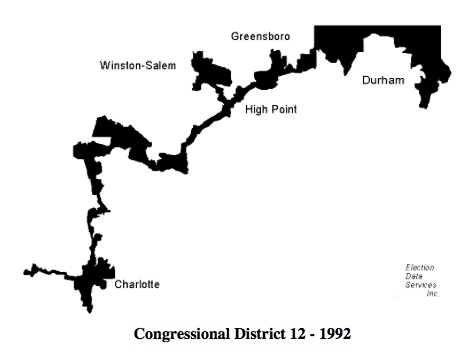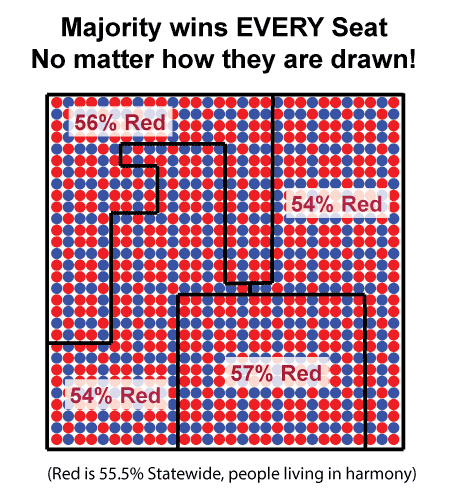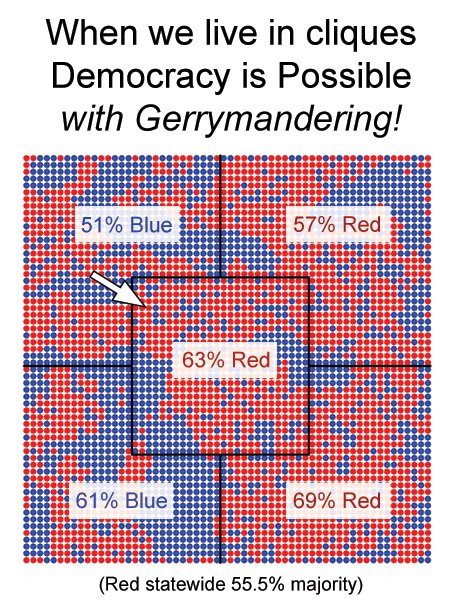| g e n u i n e i d e a s | ||||||
 |
 |
 |
 |
 |
 |
 |
| home | art and science |
writings | biography | food | inventions | search |
| Sept 2017 |
|
Why Gerrymandering is Good and Necessary
By now almost everyone is aware of the evils of gerrymandering. Where the majority party draws a congressional district solely to benefit their own agenda. Or to disenfranchise people who are not like themselves. At its most blatant, gerrymandered districts may look like this tortuous, 160 mile-wide ink blot connecting five cities:
But why not, you ask, adopt the obvious remedy? Just mandate compact districts by law, and the mischief will end. Stopping gerrymandering in its tracks. Unfortunately, you are probably not aware that gerrymandering is actually part of the solution. And that compact maps can be manipulated just as effectively as a district that looks like cracked mud. Even more surprisingly, if you want to assure an elected legislature proportionately represents the views of its citizens, you must settle near kindred spirits, or risk disenfranchisement. Really? Living in an echo chamber is good? Compact districts can be unfair? To understand why, imagine you reside in a harmonious Eden where we respect each other's differences and live peaceably side-by-side. Perfectly desegregated. With both parties spread uniformly across the state:
Since RED voters slightly outnumber BLUE in this state, a fair and representative outcome in a four district contest would elect two RED and two BLUE congressmen, or perhaps three RED and one BLUE. If it weren't for pesky gerrymandering perverting the course of democracy. But when people are not geographically segregated into communities-of-interest, EVERY district shape, no matter how compact or jagged, leads to the same outcome:
Surely this artificial, regular pattern of voters must be the problem. How does gerrymandering operate when the voters are randomly distributed? As before, no matter how the districts are drawn, a majority party's tiny advantage snowballs into winning every election:
Clearly a perverse outcome. In this mythical paradise, BLUE citizens are NEVER able to elect their own representatives! Even though voters trust and respect their neighbors, by living shoulder to shoulder they suffer under a Tyranny of the Majority. Then why are most states delegations about evenly split? Well, the fact is we don't live in a mythical Eden. For economic, social and historical reasons, people tend to cluster near people like themselves. Farmers near farmers, rich near rich, democrats near democrats. By concentrating minority party voters into a few select districts where they become the de facto majority, the election is potentially more representative. Unfortunately, with clustering there are no guarantees of fairness, even with compact districts. Here is a simple, but extreme example of complete geographic segregation by party. RED will win one, two or three seats, depending on how the cake is cut:
It pays to be the person holding the knife... Now imagine (as in the real-world) we reside in more realistic overlapping cliques. In this specific example, electing three RED and two BLUE legislators:
A pretty fair outcome. But sometimes the clusters don't line up with existing district boundaries, and BLUE still loses every contest. Clustering is necessary, but not sufficient to assure a representative election. There are a couple of ways out of this predicament. One method is to anoint a few communities-of-interest as "protected" classes. Perhaps race, gender and even political party. Then task an independent commission to gerrymander districts to ensure, on average, the election results mirror the underlying protected-class percentages. This is the fairer side of gerrymandering. It's also the status quo in the majority of states. Without an independent commission, you can imagine the immense temptation for RED legislators to slightly tweak the center district's boundary away from the upper left's BLUE region (near the white arrow). Just by interchanging a few voters across the border (while still maintaining a smooth and "fair" outline), BLUE loses its seat. And if a bit of tweaking won't do, you can alway blaze a crooked trail between islands of RED supporters to win the district. The devious face of gerrymandering. Still, the entire process is hardly comforting. Why not ten protected classes, instead of three? And why is geography so important? Why not let Facebook groups or socio-economic status guide the independent commission? These communities of interest are filled with passionate citizens who want their voice to be heard, and may care more about animal rights or capital gains taxes, than about their neighbors. One solution is to move away from geographic districts to state-wide, at-large elections (here is my proposal). At-large voting is imperfect, but fairer than districts, and could deflate some of the partisanship blocking government from doing its job. At-large voting has a long history in the US, and outside the country is widely and successfully practiced to achieve a representative government. But in the US there is no explicit, Constitutional basis for proportional representation. The most realistic opportunity for progress occurs if the Supreme Court anoints political parties as protected groups. Then independent commissions could gerrymander districts to assure a slightly fairer election. Even if that requires fractally twisted district maps. Democracy in the 21st century.
|
Contact Greg Blonder by email here - Modified Genuine Ideas, LLC. |





